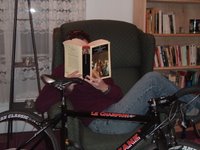I'm reading slowly these days, although fairly steadily; I'm maybe 1/3 of the way through Dracula, and finding some more funny footnotes, although nothing as good as the ones here. The editor gets pedantic about the ways the blood transfusions in Dracula are completely unrealistic, peppering the narrative with corrective comments. Here are a whole series of footnotes to a passage that's about a page long: In real life the hugger-mugger blood transfusions that follow would almost certainly kill both donor and patient, since no effort is made by Van Helsing or Seward to match blood types, which, in any event, they could not have known about until nearly three decades later. For those living at the end of the twentieth century, in the age of AIDS, this can be an especially poignant scene. Veins are never empty. They are full of serum plus red blood cells. The brightest blood is dilute, anemic blood. On the other hand, adequate normal blood is dark. Stoker lays the groundwork for the erotic meaning of the blood transactions that are to come. Narcotics are for pain; narcoleptic drugs and hypnotics are for sleep. Fibrin is the clotting material in blood. Did he transfuse the blood directly or use a receptacle? If the loss of blood was telling on Arthur, it would be because he had given Lucy more than two pints of his own blood. The healthy adult human body has four or five quarts of blood flowing in it. Modern bloodbank practice is to limit blood donations to one pint at prescribed intervals. The Zoological Gardens, in the northwest corner of Regent's Park, were open daily from 9:00 A.M. to sunset. Admission was (in Stoker's time) one shilling, except on Monday, when it was sixpence. Children were half price. In a more God-fearing age than ours, the zoo was closed on Sunday. On summer Saturdays at 4:00 P.M. there was a military band concert at the zoo. Visitors were cautioned not to get too close to the llamas "on account of [their] unpleasant expectorating propensities." The unpleasant odor of the monkey house was "judiciously disguised by numerous plants and flowers." Readers of Dracula will want to know that unaccountably the zoo's bats were kept in the monkey house. We went round to the back of the house, where there was a kitchen window. The Professor took a small surgical saw from his case, and handing it to me, pointed to the iron bars which guarded the window. I attacked them at once and had very soon cut through three of them. An unlikely story. An energetic undergraduate, using a modern high carbon steel surgical saw against an iron strap one eighth of an inch thick, was able to cut one-fourth of an inch into the strap in half an hour. Assuming that Seward was cutting into bars of modest thickness, three quarters of an inch per bar, the task of cutting three such bars should have taken five hours. This is to say nothing about the condition of the surgical saw which, in the modern experiment, was rendered nearly useless for iron bars and absolutely useless for surgery. On the other hand, Seward was desperate.
It makes its own story, doesn't it? It IS rather Pale Fire-like.
This footnote made me laugh out loud; to understand its humor, you have to remember that there are no llamas or monkeys in the book (as least as far as I know -- although other animals are important), and military bands make no appearance whatsoever:
I love the "God-fearing age" detail and I do wonder, I really wonder, why the editor thought expectorating llamas and smelly monkeys were necessary to mention. And okay, there IS a bat in the book, a very important one, but why I'd want to know that the zoo's bats were kept with monkeys I'm not sure.
And finally, another reassurance that our editor is doing his research. Here's a passage from the novel:
Here's the footnote:
So how's that for active, experiential learning?
Oh, and I do like Dracula itself, very much. One day I'll post on it. It's just that the footnotes are so ... great.
Saturday, September 16, 2006
More footnotes
Posted by
Rebecca H.
at
8:20 AM
![]()
Subscribe to:
Comment Feed (RSS)



|